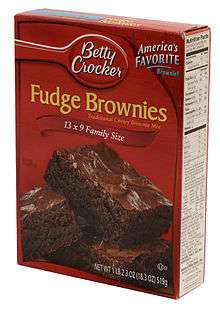Betty Crocker


Betty Crocker is a fictional character used in advertising campaigns for food and recipes, originally by the Washburn-Crosby Company, today General Mills, an American Fortune 500 corporation which owns the brand name and trademark. Betty epitomizes a motherly, caring and knowledgeable homemaker offering cooking and housekeeping advice. A portrait of Betty Crocker, first commissioned in 1936 and revised several times since, appears on printed advertisements and product packaging. On television and radio broadcasts, Betty Crocker was acted by several actresses, most notably by Adelaide Hawley Cumming between 1949 and 1964.
The character was first developed by Marjorie Husted in 1921 as a way to give a personalized response to consumer product questions. The name Betty was selected because it was viewed as a cheery, all-American name. It was paired with the last name Crocker, in honor of William Crocker, a Washburn Crosby Company director.[1]
Described as an American cultural icon, image of Betty Crocker has endured several generations, adapting to changing social, political and economic currents.[2] Apart from advertising campaigns in printed, broadcast and digital media, she received a number of cultural references in film, literature, music and comics.
Founding
Betty Crocker was created in 1921 by Marjorie Husted, a home economist and businesswoman, and advertiser Bruce Barton.[3] Under Husted's supervision the image of Betty Crocker became an icon for General Mills. In 1928, Washburn Crosby merged with five or more other milling companies to form General Mills.[2]
In 1924, Betty acquired a voice with the debut of "The Betty Crocker Cooking School of the Air" on one station in Minneapolis. It was the country's first radio cooking show, and Agnes White was selected to portray Betty Crocker. The show proved popular, and eventually was carried nationally on NBC Radio, with Agnes as Betty. Over the next two decades, Agnes would anonymously portray Betty Crocker on the air and at cooking schools.[4]
In 1929, Betty Crocker coupons were introduced. Inserted in bags of flour, they could be used to reduce the cost of Oneida Limited flatware. By 1932, this scheme had become so popular that General Mills began to offer an entire set of flatware; the pattern was called "Friendship" (later renamed "Medality"). In 1937 the coupons were printed on the outside of packages, copy on which told purchasers to "save and redeem for big savings on fine kitchen and home accessories in our catalog".
Cookbook publications
From 1930, General Mills issued softbound recipe books, including in 1933 Betty Crocker's 101 Delicious Bisquick Creations, As Made and Served by Well-Known Gracious Hostesses, Famous Chefs, Distinguished Epicures and Smart Luminaries of Movieland.
1941-1945: Betty Crocker Cook Book of All-Purpose Baking. (published as an aid to wartime considerations in cooking).[5]
In 1950, the Betty Crocker Picture Cookbook was published. It was written by Agnes White Tizard, a nutritionist and a member of Alpha Delta Pi sorority.[6]
In 2005, the 10th edition of the Betty Crocker cookbook was published, as well as a Spanish/English bilingual book that collects some of the more common recipes for Spanish-speaking readers looking to cook American-style food. An 11th edition, in ring-binder format, appeared in 2011. At least 17 other Betty Crocker recipe collections were also in print in 2015. Recipes and collections are also available digitally.
Media
Betty Crocker programs first appeared on radio on local stations in 1924. The first network Betty Crocker broadcast was on NBC in 1926. The show remained on network radio until 1953; most of the time the program was on NBC or CBS, but it was on ABC from 1947 to 1953.[7]
In 1949, actress Adelaide Hawley Cumming became Betty Crocker for many years. She appeared for several years on The George Burns and Gracie Allen Show,[8] and even had her own TV show. She also appeared in the CBS network's first color commercial, in which she baked a "mystery fruit cake". Hawley continued to portray Betty Crocker until 1964.[9]
A portrait of Betty Crocker was first commissioned in 1936, a "motherly image" that "blended the features of several Home Service Department members" that was painted by Neysa McMein.[10] It subtly changed over the years, but always accommodated General Mills' cultural perception of the American homemaker — knowledgeable and caring. The 1996 portrait of Betty Crocker, according to General Mills, was partially inspired by a "computerized composite" of "75 women of diverse backgrounds and ages."[11] These portraits were always painted, with no real person ever having posed as a model.
In 1945, Fortune magazine named Betty Crocker the second most popular woman in America; Eleanor Roosevelt was named first.[12] Fortune published an article "outing" Betty Crocker's fictitious nature, calling her a "fake" and a "fraud."[8]
In the webcomic Homestuck, Betty Crocker is used as a plot element throughout some of the duration of the story. Betty Crocker was referenced as becoming a corrupt corporation now named "Crockercorp" and building commercial drones, hiding subliminal propaganda in its product packaging. One of the characters, Jane Crocker, is the heiress to this new company based off Betty Crocker.
Legacy
The Minneapolis suburb of Golden Valley, Minnesota (where General Mills is headquartered) has a street named Betty Crocker Drive.[13]
There are a number of Betty Crocker-branded products, such as plastic food containers and measuring cups, and a line of small appliances like popcorn poppers and sandwich makers with the Betty Crocker brand name.
In 2006, the Betty Crocker catalog operation went out of business with all of its inventory on sale. Points were redeemable until December 15, 2006. A new online store was launched in April 2007, but discontinued sometime thereafter.
Betty Crocker recipes and tips from the "Atomic Age" of the 1950s are of cultural interest.[14][15]
Products
- Bac-Os
- Betty Crocker Brownie bar
- Betty Crocker Cookbook
- Betty Crocker baking mixes
- Betty Crocker canned frosting
- Bowl Appetit shelf-stable entrees
- Betty Crocker Soda Licious (discontinued)
- Cake and dessert decorating products
- Dunk-a-roos
- Fruit by the Foot
- Fruit Gushers[16]
- Hamburger Helper and related products
- Potato Buds instant mashed potatoes
- Suddenly Salad mixes
- 'Shake and make' pancake mix
- Warm Delights microwavable desserts
See also
References
- ↑ "The Story of Betty Crocker". Betty Crocker. Betty Crocker. Retrieved 28 April 2016.
- 1 2 Adema, Pauline (2006). Dennis Hall; Susan G. Hall, eds. American Icons: An Encyclopedia of the People, Places, and Things that Have Shaped Our Culture. Greenwood Publishing Group. pp. 73–. ISBN 978-0-313-02767-3.
- ↑ Charles H. Lippy (2005). Do Real Men Pray?: Images of the Christian Man and Male Spirituality in White Protestant America. Univ. of Tennessee Press. pp. 133–. ISBN 978-1-57233-358-1.
- ↑ "Agnes White Tizard: Betty Crocker". Retrieved 14 January 2014.
- ↑ Jarvits, Janet. "Betty Crocker Edition History". General Mills.
- ↑ "Accomplished Alpha Delta Pi Members in Education and Science". Retrieved 26 February 2011.
- ↑ Dunning, John. (1998). On the Air: The Encyclopedia of Old-Time Radio. Oxford University Press. ISBN 978-0-19-507678-3. P. 82.
- 1 2 Dakss, Brian (May 6, 2005). "Betty Crocker Unveiled". CBS News Sunday Morning. CBS.
- ↑ "Adelaide Hawley Cumming, 93, Television's First Betty Crocker". The New York Times. The New York Times. Retrieved 28 April 2016.
- ↑ http://www.saic.edu/150/bold-suffragette-betty-crocker
- ↑ "The Betty Crocker Portraits". General Mills. Retrieved 7 January 2013.
- ↑ Marks, Susan (2005). Finding Betty Crocker : the secret life of America's first lady of food. New York: Simon & Schuster. ISBN 0743265017. LCCN 2004061566. OCLC 56880048.
- ↑ "City Streets, Sidewalks, & Trails Map" (PDF). City of Golden Valley Minnesota. City of Golden Valley, Minnesota. Retrieved 28 April 2016.
- ↑ Tamar Adler (October 27, 2015). "Betty Crocker's Absurd, Gorgeous Atomic-Age Creations The iconic brand's midcentury recipes evoke the era's peculiar optimism, encased in gelatin and smothered in mayonnaise.". The New York Times Magazine. Retrieved November 1, 2015.
segment of American culinary life is on display
- ↑ "A Box of Betty" (Images). aboxofbetty.tumblr.com. Tumbir. Retrieved November 1, 2015.
- ↑ Betty Crocker product list, General Mills
Sources
- Tori Avey (February 15, 2013). "Who Was Betty Crocker?". PBS Food.
- Dunning, John. On the Air: The Encyclopedia of Old-Time Radio. Oxford University Press, 1998. ISBN 0-19-507678-8
- Marks, Susan. (2007) Finding Betty Crocker: The Secret Life of America's First Lady of Food University of Minnesota Press. ISBN 978-0-8166-5018-7 (popular book.)
- Crocker, Betty. Betty Crocker's Picture Cook Book. New York: McGraw–Hill and General Mills, 1950 (first edition of the "Big Red" cookbook.)
- Gray, James. Business without Boundary: The Story of General Mills. Minneapolis: University of Minnesota Press, 1954 (scholarly history of General Mills, including the invention of Crocker.)
- Shapiro, Laura. "Is She Real?" In Something from the Oven: Reinventing Dinner in 1950s America, 169–209. New York: Viking, 2004 (chapter on Betty Crocker in a popular book with footnotes.)
External links
- Betty Crocker in MNopedia, the Minnesota Encyclopedia
- www.bettycrocker.com — Betty Crocker official site
- www.bettycrocker.com/products — Betty Crocker products
- Who was Betty Crocker, GMU
- Marks, Susan, Finding Betty Crocker, archived from the original on 2008-03-08
- Fish Hawley Cumming, Adelaide, Biography, I love the Fingerlakes.
